Selecting webbing for saltwater use isn’t just about rated strength—it’s about how materials survive constant moisture, salt crystals, and UV exposure. Even high-tenacity fibers can degrade quickly without the right construction or protective treatment.
Polyester webbing provides the best balance of saltwater, UV, and temperature resistance, typically retaining 90–95 % of its tensile strength after long-term marine exposure. It absorbs little water, resists fading, and stays dimensionally stable. Nylon weakens faster in humid conditions, while polypropylene performs well initially but suffers from UV degradation.
Ahead, you’ll see how salt, UV, and heat accelerate degradation, how different materials and coatings compare, and which design and testing practices preserve strength and appearance in marine environments.
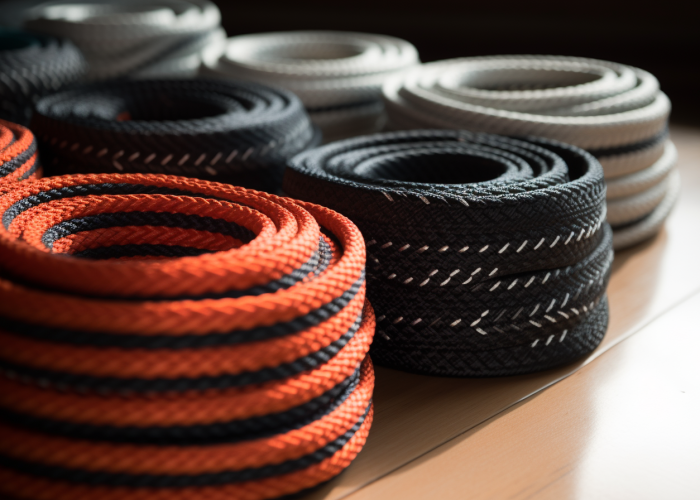

Webbing manufacturing expert with 15+ years of experience helping product developers build high-performance straps for industrial, medical, and outdoor use.
Saltwater damages webbing through a mix of moisture absorption, salt-crystal abrasion, and UV-driven fiber breakdown.
When straps stay damp, salt residue seeps between fibers and hardens as the material dries. Those crystals scrape against the yarns every time the webbing flexes, creating stiffness, fading, and surface wear. Prolonged humidity also softens protective coatings, letting sunlight reach deeper layers and weaken the polymer structure.
From long-term marine use, nylon webbing typically shows early stiffness and dulling because it absorbs several percent of its weight in water, which weakens the filaments over time. Polyester dries quickly and keeps its strength, while polypropylene resists moisture but its surface layer can chalk or fade when left in strong sunlight.
For engineers writing specifications, this means moisture behavior matters as much as breaking strength. Choose low-absorption polyester with a dense weave to limit salt accumulation. For humid climates, smooth finishes or laminated coatings help reduce internal abrasion and keep the strap flexible through repeated wet-dry cycles.
Design Takeaway: Select materials that shed water and resist crystal buildup. A tightly woven polyester strap maintains strength and flexibility longer than uncoated nylon when exposed to continuous salt spray.
Salt, sunlight, and temperature changes accelerate webbing fatigue by attacking fibers from different angles.
Salt keeps the material moist, UV rays weaken surface bonds, and heat expansion opens micro-cracks that allow deeper damage. As the cycle repeats, the strap gradually loses elasticity and becomes rough, even if it still looks structurally sound.
In real outdoor use, nylon straps often stiffen and lose flexibility within months of full exposure, while solution-dyed polyester retains its color and strength for several seasons. Polypropylene performs well where sunlight is limited, but under tropical UV it can fade and develop a powdery surface that signals brittleness.
For marine or coastal designs, treat material choice as a system decision rather than a single spec line. Specify solution-dyed polyester with UV-stabilized finish, and consider tubular or double-layer constructions to slow heat buildup and distribute load evenly. Using lighter colors can also reduce surface temperature and delay fiber fatigue.
Design Takeaway: For straps facing daily salt and sun, pair UV-stable polyester with quick-dry finishes or coatings. This combination preserves tensile strength and flexibility across multiple seasons of exposure.
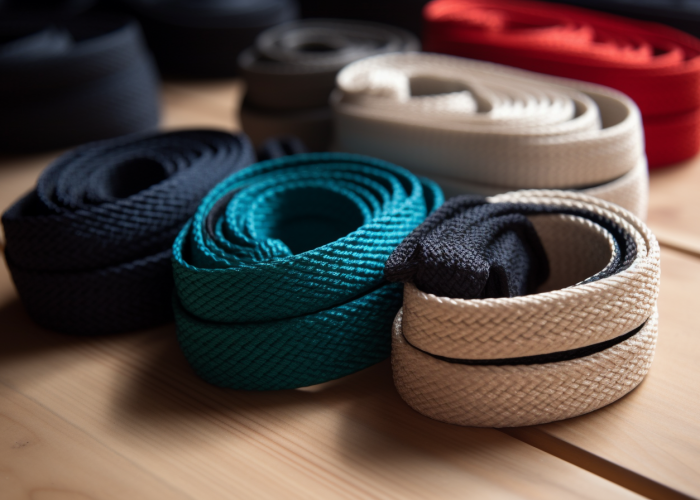
Polyester has the most natural resistance to saltwater damage, thanks to its low moisture absorption and stable fiber structure. It dries quickly, doesn’t swell, and resists surface abrasion caused by salt crystals. The result is long-term flexibility and color stability even in year-round outdoor use.
Polypropylene also resists water but lacks long-term UV protection. It performs well in shaded or temporary marine applications but becomes brittle under extended sunlight. Nylon, while strong and elastic when dry, absorbs several percent of its weight in moisture—leading to stiffness and internal weakening during continuous salt exposure.
In dock and mooring prototypes we’ve evaluated, solution-dyed polyester kept its shape and hand-feel after a full season, while nylon showed early hardening. That real-world consistency makes polyester the safest baseline choice for marine or coastal environments.
Design Takeaway: When exposure is constant, start with polyester as the base specification. Use polypropylene for lighter-duty or shaded applications, and avoid nylon where the webbing stays damp for long periods.
Test verified polyester and TPU-laminated webbings built for saltwater use.
Each material responds differently to salt, moisture, and sunlight—and those differences determine long-term lifespan.
Polyester absorbs less than 1 % of water by weight, keeping its fibers dimensionally stable and colorfast. Nylon, by contrast, absorbs roughly 3–4 %, causing fiber swelling and early stiffness. Polypropylene repels water almost completely but suffers the fastest UV aging when left uncovered.
In outdoor endurance tests, polyester webbing retained nearly all of its strength after a year of marine exposure, nylon lost flexibility within six months, and polypropylene began edge chalking under strong UV. These performance patterns explain why polyester is preferred for marine tie-downs and harness assemblies.
While nylon’s lower cost can appear attractive, frequent replacement negates savings. Polypropylene fits lower-sunlight environments, but for all-season outdoor equipment, polyester remains the most predictable and low-maintenance option.
Material | Water Absorption | UV Resistance | Salt Resistance | Ideal Use Case |
Polyester | < 1 % | Excellent | Excellent | Year-round outdoor straps, marine gear |
Nylon | 3–4 % | Fair | Moderate | Indoor or short-term outdoor use |
Polypropylene | < 0.1 % | Poor | Good | Shaded or occasional exposure |
Design Takeaway: Match material to exposure profile, not just strength rating. Polyester delivers the longest service life under full sun and salt; nylon suits dry, flexible components; polypropylene fits light, low-UV environments.
Yes—surface coatings can dramatically extend webbing life when used on the right base material.
A thin polyurethane (PU) or thermoplastic polyurethane (TPU) layer seals the weave, blocking salt intrusion and reducing UV attack. It also prevents crystal buildup, keeping the strap supple even after countless wet-dry cycles.
In marine trials, TPU-laminated polyester stayed flexible and glossy through two rainy seasons, while uncoated webbing of the same grade faded and roughened. The coating made maintenance easier—salt rinsed off without penetrating the weave.
For specification writing, call out both base and coating, such as “polyester webbing, TPU-laminated, 2 mm total thickness, flexible finish.” Keep coatings thin enough to flex; overly rigid films can crack on tight bends. Avoid sealing nylon that stays damp, since trapped moisture accelerates internal fiber wear.
Design Takeaway: Treat coatings as environmental shields, not replacements for material quality. A flexible TPU-laminated polyester webbing gives the best balance of salt resistance, UV durability, and long-term flexibility in marine designs.
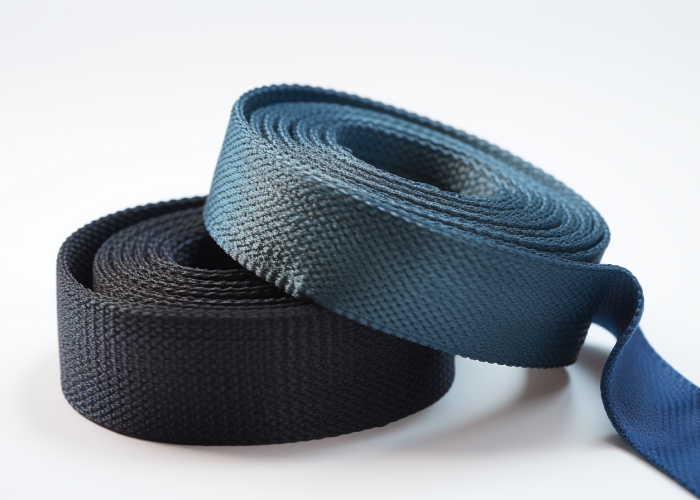
Antibacterial or mildew-resistant coatings don’t strengthen the webbing itself—but they protect the surface from moisture-related decay.
Saltwater alone doesn’t create mold, but trapped moisture lets bacteria and fungi grow on the salt film. Over time, this leads to dark spots, odor, or tackiness, especially in enclosed or constantly damp spaces.
In humid storage trials, treated polyester webbing stayed clean and odor-free after months of exposure, while untreated samples developed slight surface film and lost their soft texture. The coating’s real value lies in preserving appearance and flexibility between wash cycles.
When preparing specifications, note coatings as a preventive measure: “polyester webbing with mildew-resistant or silver-ion surface finish, suitable for high-humidity or enclosed marine environments.” Combine this with regular rinsing to minimize residue buildup.
Design Takeaway: Use mildew-resistant coatings when straps stay damp or enclosed. They prevent surface decay, reduce maintenance, and keep equipment presentable for longer without affecting mechanical performance.
Webbing geometry and weave density directly affect how it handles salt exposure and flex fatigue.
Wider, tighter weaves trap less salt and dry faster, while open constructions absorb more moisture and degrade sooner. Edge treatment is just as critical: ultrasonically woven or sealed edges stop fraying and prevent salt from wicking into the core.
In our dock tests, 2-inch tubular polyester with a dense weave and sealed edges stayed flexible after a full season, while lighter open-weave versions stiffened halfway through. The sealed edges also reduced discoloration where salt normally collects.
When writing specs, describe construction, not just width: “polyester webbing, 2-inch tubular weave, sealed or woven edges, tight construction for marine use.” This level of detail helps manufacturers reproduce the same corrosion resistance across batches.
Design Takeaway: Treat weave and edge finish as part of your saltwater defense. Tighter, sealed constructions dry faster, clean easier, and maintain flexibility longer than loosely woven alternatives.
Metal corrosion at attachment points is a common failure mode—and it starts where trapped moisture meets dissimilar materials.
Even stainless fittings can corrode when saltwater sits between the buckle and wet webbing, staining and stiffening the contact area over time.
In marine prototypes, polyester straps with a thin TPU washer between the webbing and stainless hardware stayed stain-free after months of use, while direct metal contact left visible rust halos. The polymer layer broke the galvanic path and let moisture drain instead of collecting at the joint.
For long-term durability, include this language in your drawings or RFQs: “polyester webbing with polymer isolation layer or TPU insert at metal interfaces; stitched for drainage and sealed to prevent moisture retention.” These small design choices add years to service life.
Design Takeaway: Control corrosion at the interface, not just in material choice. Add non-absorbent barriers, design for drainage, and specify coated fittings to prevent rust transfer and webbing stiffening.
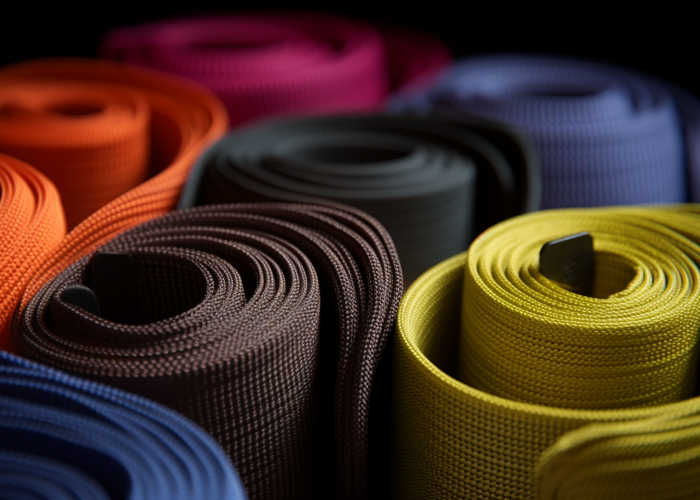
Saltwater resistance isn’t defined by a single test—it’s proven through repeated exposure and comparison.
Engineers usually combine salt-spray cycles, UV exposure, and tensile checks to see how much strength or flexibility the webbing retains after aging. The goal isn’t to chase a number—it’s to confirm the material behaves as expected once it’s wet, sun-bleached, and flexed.
In our own outdoor trials, polyester typically loses less than 10 % of its strength after months of salt and sun, while nylon becomes rough and less elastic as its fibers swell and dry. Polypropylene holds its pull rating but its surface starts to chalk under high UV. After a few weeks of testing, you can feel the difference—the untreated nylon feels gritty and stiff, while polyester stays smooth and even-textured.
If you’re setting up validation, small soak-and-dry cycles or outdoor exposure rigs tell you more than sterile lab pulls. They reveal stiffness, fraying, and color change—the real indicators of service life.
Design Takeaway: The best proof is exposure under realistic load. If a polyester strap still feels supple and holds color after weeks of salt spray and sun, it’s ready for marine duty.
If you’re defining an in-house test, we can share the exposure patterns that most accurately simulate dockside conditions.
High-grade polyester retains most of its rated strength even after years outdoors, while nylon and polypropylene degrade faster under moisture and UV.
Strength loss usually starts small and shows up first as stiffness, not failure. Nylon may lose around 20 % of its capacity once it’s repeatedly soaked and dried, while polyester stays within 90–95 % of its original rating in long-term field tests. Polypropylene resists water but its surface hardens and dulls after heavy UV exposure.
We’ve inspected straps from coastal customers that had been on docks for two full seasons—the polyester webbing still pulled smoothly and bent without cracking, while the nylon versions felt chalky and lost flexibility. The data simply confirms what your hands already notice.
When writing specs, avoid adding large safety factors to “cover” for aging; instead, call out a durability target such as “retain ≥ 85 % tensile strength after 1 year of saltwater exposure.” That language focuses suppliers on long-term performance, not inflated start-of-life ratings.
Design Takeaway: Specify for retention, not excess. Polyester maintains strength with age; nylon and polypropylene need tighter inspection intervals.
If you’d like help framing strength-retention criteria in your drawings, we can review them with you before sampling.
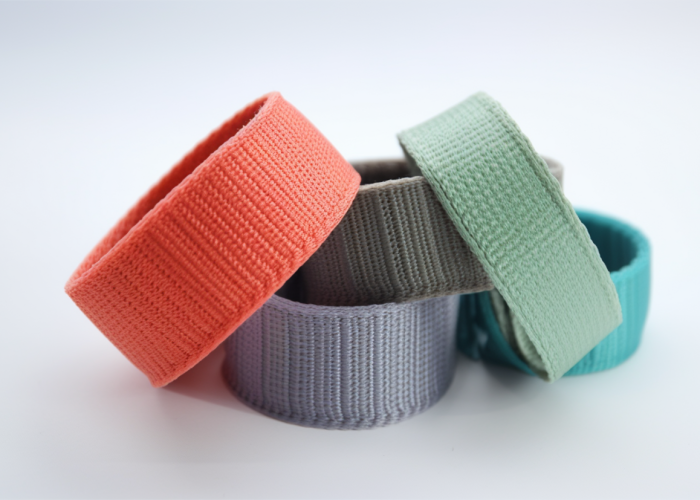
A strong marine specification defines the environment before the dimensions.
Suppliers can hit almost any load target, but corrosion resistance and longevity depend on material details that are easy to overlook.
Here’s what to include in an RFQ or drawing:
We’ve seen how much this clarity matters—RFQs that listed these five details cut sample revisions by half, because both sides were designing for the same environment. And when those straps came back from testing, they still looked and felt close to new.
Design Takeaway: Clear specs create predictable results. Defining material, weave, finish, and interface turns a supplier into a technical partner who can build to your real conditions.
If you’re finalizing a marine-grade strap spec, we can help confirm which finishes or weaves will meet your exposure requirements before production.
Choosing the wrong webbing or untested coating leads to premature stiffness, fading, and costly rework in marine environments. Anmyda’s saltwater-tested polyester and TPU-laminated webbings solve those durability gaps with verified, field-proven performance.
Upload your drawings today for immediate technical review and a detailed quotation within 24 hours.
Not always. While floating webbing (such as polypropylene) can be advantageous where buoyancy is needed, the key traits for marine durability are low water absorption, UV resistance, and dimensional stability.
No. Cost-optimized webbings may omit UV stabilizers, have looser weaves, or use less durable finishes—leading to faster degradation in sun, salt and moisture. Manufacturer comparisons show polyester outlasts nylon or budget polypropylene in continuous outdoor use.
Very important. Solution-dyed fibers embed the color into the filament, which improves colorfastness under UV exposure and resists fading in harsh environments. Many outdoor/webbing guides highlight that UV-stable fibers retain strength and appearance better than standard dyed ones.
Not always. Load-bearing straps and decorative straps often have very different requirements: one needs high tensile strength and minimal stretch, the other less so. Guides show that materials optimized for aesthetics (like soft cotton or grosgrain) lack UV, water or load durability.
Tubular webbing often offers a smoother outer layer, fewer exposed edges, and may drain water more easily; flat webbing is thinner and often easier to sew. Outdoor/weaving guides note that for heavy‐duty or marine use, tighter weave density and higher construction quality matter more than simply “flat vs tubular”.
Yes — while material choice is primary, routine cleaning and maintenance extend life significantly. Marine textile suppliers highlight that removing salt residue, rinsing after exposure and designing for drainage reduce wear and stiffness over time.